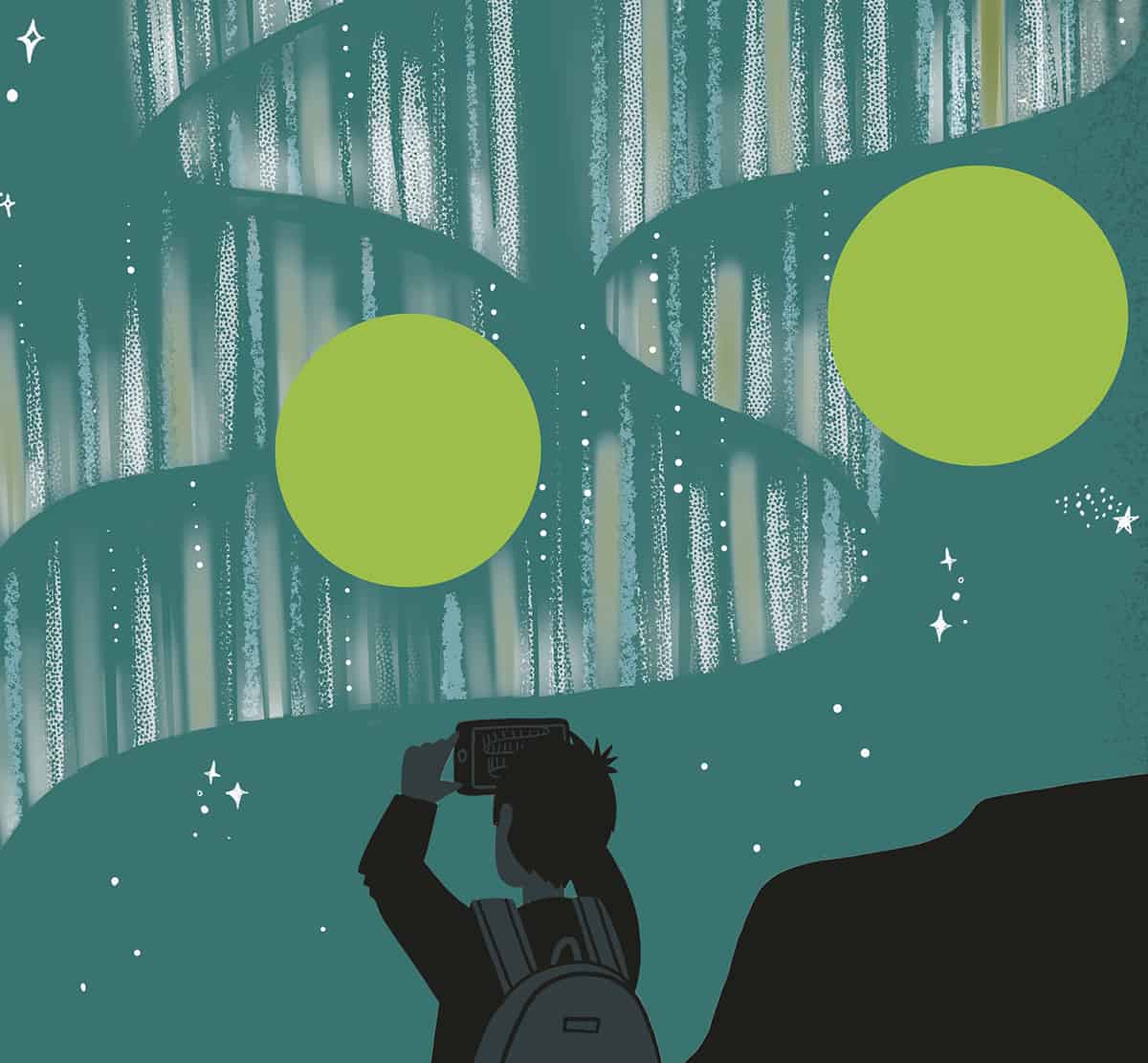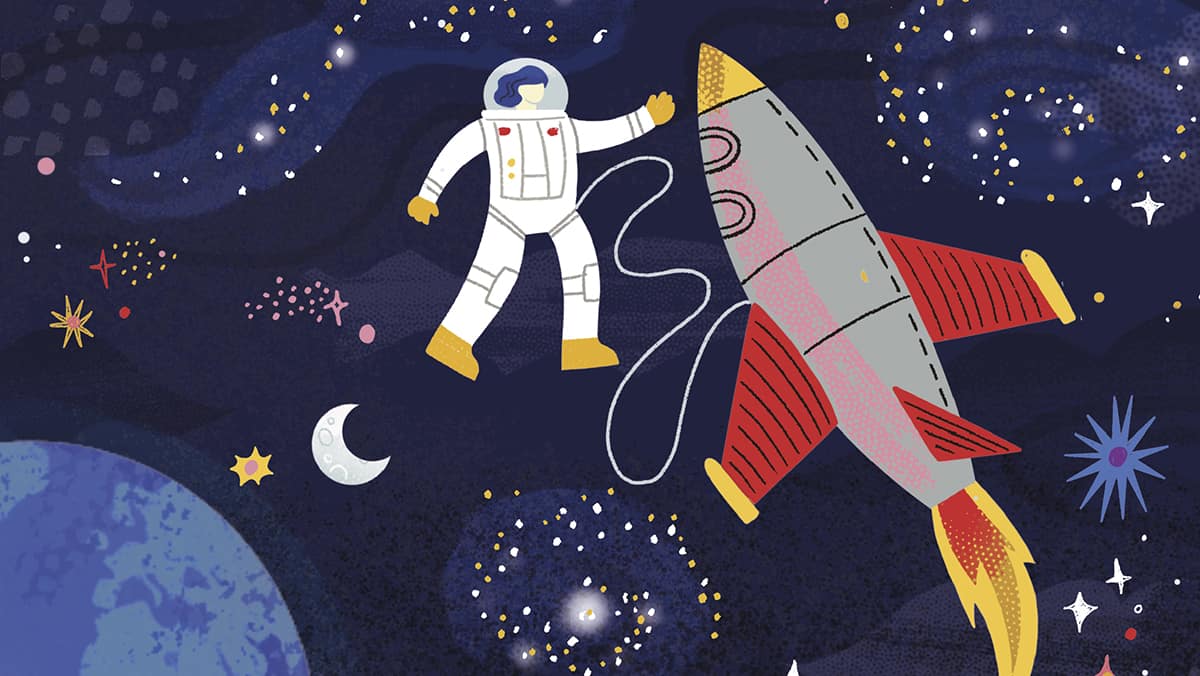Michael Banks and his son Henry, aged seven, review Can You Get Rainbows in Space? by Sheila Kanani, illustrated by Liz Kay

Kids have an insatiable appetite for knowledge and love to ask questions, sometimes to the exasperation of parents and carers. Why is the sky blue? Why do leaves change colour from green to orange? Why is blood red, but our veins blue?
If you know someone young who is curious about the world around them, then Can You Get Rainbows in Space?, a new children’s book about light and colour, could be for them. Written by planetary scientist Sheila Kanani and illustrated by Liz Kay, it is a compendium of space, science and light, told through the colours of the rainbow from red to violet and beyond.

After introducing what is meant by colour and light, each chapter focuses on a particular colour of the rainbow. Featuring fun scientific facts and trivia, every page has been nicely designed with attractive illustrations so it doesn’t feel too dense and keeps children interested.
Examples of the trivia include the fact that humans tend to avoid blue food because of the colour’s association with mould, and that carrots started out white before turning other colours such as purple and orange thanks to farming.
But Can You Get Rainbows in Space? does not just look at the six distinct visible colours. The latter chapters go beyond the rainbow to examine ultraviolet, infrared and fluorescent light, as well as what the symbolism of the rainbow represents.
I gave the book to my seven-year-old son Henry, to gauge his thoughts. He often comes home from school telling me his favourite fact of the day. “Did you know that cats can see really well in low light” was one such recent example. So this book sounded like it would be right up his street – presented at a level at which he would be able to understand the concepts and take something from it.
Despite being more than 100 pages, Henry devoured the contents over just four sittings, which is perhaps the best indicator of how much the book piqued his interest.
The following are his thoughts, edited for clarity.
“This book is about the colours of the rainbow. Each colour is given around 10 pages that contain loads of exciting scientific facts as well as details about all sorts of different things.
“I really like the facts – such as, if I put my hand on the top of a fire, the temperature could be between 500 and 1000 °C, and yellow or orange. But some super-hot fires can be even hotter, around 1000 to 3000 °C, and are blue in colour.

“Another fun fact is that flamingos are pink because of what they eat. My favourite fact is that the Sun isn’t actually yellow, but green (if you measure the energy of the Sun from space)!
“I like how the pages in each chapter are the same colour it is describing and how each page is full of fun pictures that make you want to read the facts and find out more.
“This is a fun book for children who love to find things out. Five stars.”
There you go: Can You Get Rainbows in Space? gets the thumbs up from Henry and the thumbs up from me for providing a necessary resource that parents and carers can refer to when they find themselves on the receiving end of countless questions about the colours we see in the natural world.
- 2023 Puffin Books 128pp £14.99hb
- Michael Banks is news editor of Physics World (see link below to his author page) and Henry is his son
- SEO Powered Content & PR Distribution. Get Amplified Today.
- PlatoData.Network Vertical Generative Ai. Empower Yourself. Access Here.
- PlatoAiStream. Web3 Intelligence. Knowledge Amplified. Access Here.
- PlatoESG. Automotive / EVs, Carbon, CleanTech, Energy, Environment, Solar, Waste Management. Access Here.
- BlockOffsets. Modernizing Environmental Offset Ownership. Access Here.
- Source: https://physicsworld.com/a/our-colourful-world-an-illustrated-journey-through-the-rainbow/
- :has
- :is
- :not
- :where
- $UP
- 10
- 100
- 3000
- 500
- a
- Able
- About
- AC
- across
- actually
- aged
- All
- also
- an
- and
- appetite
- ARE
- around
- AS
- Association
- astronaut
- At
- attractive
- Aurora
- author
- avoid
- BE
- because
- been
- before
- being
- below
- BEST
- between
- Beyond
- blood
- Blue
- book
- Books
- but
- by
- CAN
- Cats
- change
- Chapter
- child
- Children
- clarity
- click
- CO
- comes
- concepts
- contain
- contents
- could
- created
- curious
- day
- designed
- details
- different
- distinct
- do
- does
- Doesn’t
- done
- each
- eat
- editor
- end
- energy
- Even
- Every
- examine
- example
- exciting
- Explains
- fact
- facts
- farming
- Featuring
- feel
- Find
- Fire
- fires
- focuses
- following
- food
- For
- four
- from
- full
- fun
- gauge
- get
- given
- Go
- Green
- hand
- Have
- he
- henry
- his
- Home
- How
- HTTPS
- Humans
- i
- if
- image
- in
- Indicator
- information
- interest
- interested
- introducing
- issue
- IT
- journey
- jpg
- just
- Know
- knowledge
- Level
- light
- like
- LINK
- loads
- Look
- love
- Low
- make
- max-width
- me
- meant
- measure
- more
- much
- my
- Natural
- necessary
- New
- news
- of
- often
- on
- ONE
- open
- or
- Orange
- Other
- our
- out
- over
- page
- pages
- parents
- particular
- perhaps
- photo
- Physics
- Physics World
- plato
- Plato Data Intelligence
- PlatoData
- presented
- providing
- put
- Questions
- Read
- really
- receiving
- recent
- Red
- represents
- resource
- review
- right
- same
- School
- Science
- scientific
- Scientist
- see
- seven
- SIX
- Sky
- So
- solar
- some
- Someone
- something
- son
- sounded
- Space
- Spectrum
- Stars
- started
- street
- such
- Sun
- Take
- taking
- telescope
- than
- Thanks
- that
- The
- the world
- Them
- themselves
- then
- they
- things
- this
- Through
- thumbnail
- to
- too
- top
- true
- Turning
- understand
- Universe
- User
- using
- viewing
- visible
- want
- was
- we
- WELL
- What
- What is
- when
- which
- white
- WHO
- why
- winds
- with
- world
- would
- written
- You
- young
- zephyrnet













